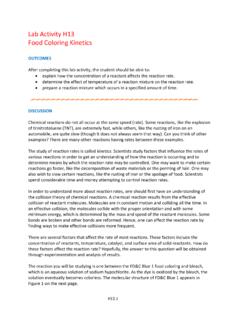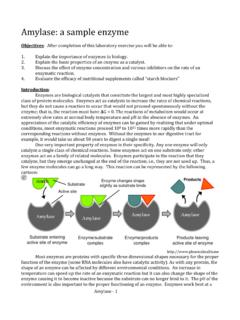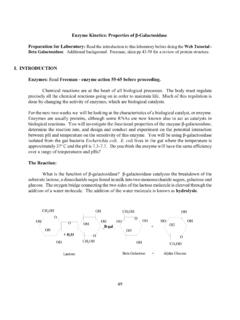Transcription of Activity 6 Reaction Rates - Courses
1 Active Chemistry4777 HAT $O 9OU 3EE Activity 6 Reaction Rates GOALSIn this Activity you will: Discover conditions that make a Reaction proceed faster or slower. Discuss explanations for why this happens at the molecular level. What Do You Think? Have you ever wondered why some chemical reactions , like the burning of a match, take place at a fast rate, while others, like the spoiling of milk, take place slowly? The rate of a chemical Reaction is the speed at which the reactants are converted to products. What are some factors that influence the rate of a Reaction ? How could you make a Reaction take place at a faster rate? How could you slow a Reaction down? Record your ideas about these questions in your Active Chemistry log. Be prepared to discuss your responses with your group and the class.
2 Investigate 1. Predict how the concentration (strength) of vinegar will affect how fast it will react with magnesium. One way to study the rate of a Reaction is to time the Reaction with a stopwatch. Try this! Place 20 mL of vinegar into a large test tube. To a second test tube, add 10 mL of vinegar and 10 mL of water. Mix well using a stirring rod. In a third test tube, add 5 mL of vinegar to 15 mL of water. Mix. Safety goggles and a lab apron must be worn at all times in a chemistry 4775/23/07 12:44:00 PM5/23/07 12:44:00 PMActive Chemistry Cool Chemistry ShowActive Chemistry478 Prepare three equal-sized pieces of polished magnesium ribbon. Set your stopwatch so that it is ready to start immediately. Add a piece of polished magnesium ribbon to the first test tube, keeping track of the time the Reaction takes. a) Record your observations and the Reaction time on a data table.
3 Repeat for the other two test ) In this step, you changed the concentration of one of the reactants (the vinegar). The vinegar was less concentrated (more dilute) in each successive test tube. Did this impact the Reaction rate? If so, describe the relationship between the concentration of the vinegar and the resulting Reaction rate. c) Compare your experimental results to the prediction you made before conducting the experiment. 2. Using the same Reaction above, design a small-scale experiment using a well-plate and smaller amounts of ) Record your design. Include the equipment you will need, the amount of reactants, and any safety procedures. b) With the approval of your teacher, carry out the procedure. Record your data and results. c) How do the results compare with the Reaction in Step 1? 3. Place 10 drops of M HCl (weak concentration) into a small test tube and 10 drops of M HCl (strong concentration) into a second test tube.
4 Drop a small piece of polished zinc (equal size) into each test tube containing HCl. a) Record your observations. b) How do these results compare to your earlier results? Do these results support or refute the relationship you stated in Step 1 (c)? 4. Hydrogen peroxide (H2O2) is sold over the counter in pharmacies to be used as a disinfectant for minor injuries. Because hydrogen peroxide decomposes slowly to form oxygen and water, it is also a source of oxygen gas. 2H2O2(aq) light energy O2(g) 2H2O(l) Pour a small amount of hydrogen peroxide into each of two test tubes. Add a small amount of manganese dioxide to one of the test ) Record your observations. The manganese dioxide did not actually react with the hydrogen peroxide; it simply acted as a catalyst for the decomposition of the hydrogen peroxide. A catalyst is a material that speeds up a Reaction without being permanently changed itself.
5 The chemical equation for this Reaction is: 2H2O2(l) MnO2 O2(g) 2H2O(l) 5. As an inquiry Activity , design an investigation to prove that the manganese dioxide did not get used up in the Reaction . Record your design. Include the equipment you will need, the amount of reagents, and any safety procedures. Be careful with the HCl. Do not get it on your 4785/23/07 12:44:02 PM5/23/07 12:44:02 PMActive Chemistry479a) Record your procedure in your Active Chemistry log. b) With the approval of your teacher, carry out the experiment. c) Record your data and results. d) Describe the relationship between the use of a catalyst and the rate of a Reaction . 6. Pour 200 mL hot water into one beaker and 200 mL ice water into another beaker. Add a tea bag to each. a) Record your results. b) Repeat the procedure using an effervescent antacid tablet in place of the tea bag.
6 Record your observations. c) Describe the relationship between temperature and the rate of Reaction , based on the two situations you studied. 7. Prepare two beakers, each containing equal amounts (about 200 mL) of room temperature water. Obtain two effervescent antacid tablets. Crush one and leave the other whole. Simultaneously add the crushed tablet to one beaker and the whole tablet to the other beaker. a) Record your observations. What factor was being studied in Step 7? b) Describe the relationship between that factor and the rate of Reaction . 8. Use the results of this Activity to answer the following: a) Describe how you could increase the rate of Reaction by altering: concentration catalyst temperature surface area 9. Dispose of all chemicals as directed by your teacher. Clean and put away any equipment as instructed.
7 Clean up your workstation. 10. Chemical systems that highlight Reaction Rates can be very interesting. Because time is a factor, these systems are often called clock reactions . Your teacher may do the following Reaction as a demonstration. Your teacher will use the following solutions: Solution A = M potassium iodate (KIO3) Solution B = 1% starch solution Solution C = M sodium hydrogen sulfite (NaHSO3) Two rows of five beakers (all the same size!) will be arranged. The front row is shown here. 100 mL of solution A, 50 mL of solution B, and 100 mL of distilled mL of solution A, 50 mL of solution B, and 105 mL of distilled water. 90 mL of solution A, 50 mL of solution B, and 110 mL of distilled mL of solution A, 50 mL of solution B, and 115 mL of distilled mL of solution A, 50 mL of solution B, and 120 mL of distilled water.
8 Each beaker in the back row contains 20 mL of solution C and 130 mL of water. Your teacher will add the contents of one beaker from the back row to the contents of one of the beakers in the front row. Use a stopwatch and stop when a color change occurs. Your teacher will then combine the next set of beakers as you again use the stopwatch. She or he will continue down the row. a) Record the time and your observations about the change in each case. Wash your hands and arms thoroughly after the 6 Reaction Rates 10009001000900800700600500400300200100 mL800700600500400300200100 mL10009001000900800700600500400300200100 mL800700600500400300200100 4795/23/07 12:44:03 PM5/23/07 12:44:03 PMActive Chemistry Cool Chemistry ShowActive Chemistry480 FACTORS AFFECTING THE RATE OF A Reaction In this Activity you investigated several common factors that influence Reaction rate.
9 The rate of Reaction is the decrease in the concentration of reactants over time. This leads to a corresponding increase in products over time. The factors you investigated included surface area, concentration of reactants, temperature, and catalysts. On a molecular level, these factors either increase or decrease the collision frequency of the particles of the materials involved in the Reaction or they lower the activation energy of the Reaction . Consider surface area. In water, a sugar cube dissolves at a much slower rate than if the same cube is first crushed. The crushed cube has a greater surface area. More parts of the sugar are in contact with the water. In a fireplace, wood chips burn faster than a pile of logs. In your Activity , the crushed effervescent antacid tablet probably reacted faster. In all of these cases, the smaller pieces, with their increased surface area, allow the particles that are reacting to come in contact with each other more often.
10 This increases the collision frequency. Another factor that influences Reaction rate is the concentration of the reactants. You investigated increases of concentration with vinegar and with hydrochloric acid. An increase in concentration means an increase in the number of particles in the Reaction . This results in an increase in the collision frequency. If a chemist wants to increase the rate of a Reaction , an increase in the concentration of one or more of the reactants will do the trick. Altering collision frequency and efficiency can also be accomplished through temperature changes. According to the kinetic theory, particles move faster at higher temperatures and slower at lower temperatures. The faster motion of the particles increases the energy of the particles and increases the probability that particles will collide. In addition, increasing the temperature of the reactants increases the number of particles that have an energy that equals or exceeds the activation energy required for the Reaction to take place.










